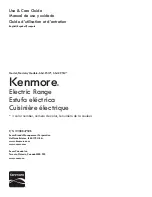
25
Oven Cooking Guidelines:
Do not block the ducts on the rear of the range when
using the oven. It is important that there is a continuous
flow of hot air from the oven and fresh air into the oven
burner. Avoid touching the vent opening or nearby
surfaces during oven or broiler operation--they may
become hot.
• Keep oven door closed when using oven (bake or broil modes).
• Never use aluminum foil to cover the oven shelves or to line the floor of the
oven. This can trap heat, irreversibly damaging the enamel and may even
cause fire.
• Do not place water, ice, or any cookware or tray directly on the oven floor,
as this will irreversibly damage the enamel.
• Do not cover the slotted grid of the broil/roast pan with aluminum foil.
This will catch grease and could catch fire.
• Do not use plastic wrap or wax paper in the oven.
• To ensure food safety, do not leave food in the oven for longer than two
hours before and after cooking or defrosting. This is to avoid contamination
by bacteria that could cause food poisoning. Take particular care during
warmer weather. According to the United Sates Department of Agriculture,
DO NOT hold foods at temperatures between 40ºF to 140ºF more than 2
hours. Cooking raw foods below 275ºF is not recommended.
• Never cover any slots, holes or passages in the oven bottom or cover an
entire rack with materials such as aluminum foil. Doing so blocks air flow
through the oven and may cause carbon monoxide poisoning.
• Aluminum foil lining may also trap heat, causing a fire hazard.
Oven Function:
Natural Airflow Bake occurs when heat is transferred into the oven from the
bake burners in the bottom of the oven cavity. Heat is then circulated by
natural airflow. This is a traditional bake setting.
Infrared Broiler:
The broil burner is located at the top of the oven, with an output of 16,500
BTUs. This burner heats the metal screen until it glows. The glowing screen
produces infrared heat, searing the outside of broiled foods and sealing in
juices.
OVEN USE
!
IMPORTANT
















































